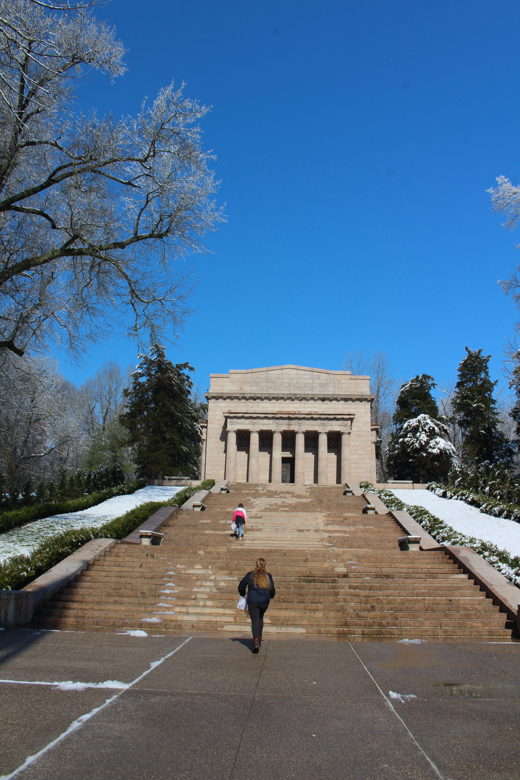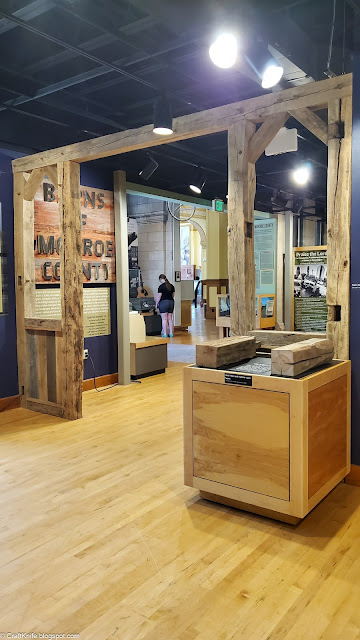.jpg)
Our collective family favorite hobby is so boring that I'm honestly a little embarrassed to tell you about it.
No, it's not how we like to sit around a table and work puzzles while listening to audiobooks. That's genuinely awesome and not embarrassing at all.
It's embarrassing how much take-out pizza we eat, but that's not really a hobby.
Our hobby of making themed dinners and then watching movies while we eat is so cool that I don't understand why everybody else also doesn't do this weekly. Don't y'all WANT to be eating rainbow foods while sitting in your living room and watching Priscilla, Queen of the Desert? It's very fun!
This other hobby of ours is also very fun, but only in a very, very specific and highly-focused way, and probably only for us:
Basically, we drive to some seemingly random, poky little town and we just... poke around it? We get ice cream, check out the historical markers, browse the local shops, and exclaim over the most boring shit like, "Ooh, look at the limestone detail on that bank!" and "I wonder why they've got a Civil War cannon in their playground? Let's go climb on it!"
Just writing this out, it feels like an objectively awful way to spend a full day. The drive there and back is always ridiculously long, too, and requires verbally acknowledging every falling-down old barn and even slightly unusual farm animal we pass. This Sunday, y'all, we saw THREE miniature ponies! And a horse grazing in the same field with a bunch of cows! Many cornfields! A giant paintball arena out in the middle of nowhere cut out from the cornfields! Several threshing barns!
But I don't know, you guys. It is also, for some reason, a stupid amount of fun.
This particular adventure was inspired by Father's Day. We're also pretty obsessed with activity trails, either packaged ones like the Garfield Trail or ones that we DIY, like the indie bookstore trail that was my older kid's birthday gift a couple of years ago. We spent most of the pandemic doing a Southern Indiana Ice Cream Trail, and it might have been the thing that preserved my partner's sanity. He was PISSED when we finally completed the trail, sent in our passports, and all we got back were trucker caps as our prizes--acting bitchy about the prize is an important part of the tradition!
So for this Father's Day, I found a giant culinary trail put together by a statewide non-profit. It's got not just ice cream, but tenderloins. Pizza. Diners, drive-ins, and dives. Pie! We all signed up for it, my partner picked our first location, and off we drove through the cornfields to Greensburg, Indiana, a town whose claim to fame is that it's halfway between Indianapolis and Cincinnati. Which, just between us, it's like two hours from Indianapolis to Cincinnati so I don't know if that's really helpful? If you lived in the middle you'd still have at least an hour commute either way, not counting city traffic, and if you were just going from one place to the other, well, it's only a two-hour drive so why would you need to stop smack in the middle?
Also, I don't understand why that's what they're promoting when as soon as we got there and parked at the town square, THIS is what we saw!!!
.jpg)
They have a tree growing out of their courthouse roof!
It was baffling and cool and charming, and honestly kind of better that there's no informational signage around at ALL to explain what you're looking at. You just look up, see a tree growing out of the courthouse roof, and exclaim and wonder over it like it's the olden days. You could also literally just miss the tree if you parked on the other side of the courthouse and/or never happened to look up, and then how stupid would you feel later if someone told you about it?
I looked it up later, and these TripAdvisor reviews are cracking me up:
Like, guys. That tree is not even there for you. You don't need to give it a 3 out of 5 rating just for existing!
And for some reason it made TrishA4 mad. Is she contractually obligated to pay for clock tower repairs or something? Did poorly maintained gutters once kill her loved one?
Well, we weren't mad. It gave us something to talk about while we ate our pork tenderloins and French fries in a beach-themed bar and grill that had faux tiki huts and people playing pool inside. I was excited about the poster for a KISS cover band coming through, until a kid pointed out that the poster was from 2015, dang it. 2015 Julie would have ALSO loved to see a KISS cover band! After lunch, we walked around the courthouse square, checking out the other nearby restaurants on the culinary trail--
.jpg)
--and then we all got completely sidetracked for over an hour in Pickers Paradise, an antique store on the square. Their uranium glass was a VERY reasonable price!
I haven't worked up the nerve to start my own uranium glass collection yet, but I covet it SOOOO bad. All I need to do is put some black lights in Mamma's old china cabinet, right? Or would I need to store everything in a lead-lined coffin and only take them out on special occasions?Anyway, I didn't buy the uranium glass, sob, but I did buy a really nice molinillo that my older kid found in a bin of kitchen accessories and recognized from a workshop on the history of chocolate that we took together last month. And then my younger kid found a really nice vintage poster in a pretty frame, and when my older kid told me about a cast iron horse bust that she'd thought was really cool I was all, "Your Dad is already buying me and your sister stuff. Go show him your horse head!" And that's how on Father's Day my partner walked out of an antique store having bought everybody BUT himself a nice little present, ahem.
But we all hugged his neck and told him we loved him!
We walked over to see a nice stretch of historic storefronts that had been restored (and then left to get slightly neglected again, but charmingly so), but our last stop before we drove back through the cornfields was another point on the culinary tour, a genuine A&W!
.jpg)
We didn't realize that this was a place where the waitstaff would come out to your car--I guess it's from the Just Cruisin' section of the culinary trail--so she threw us off our ordering game a bit. And then after she'd come and gone we realized that there was apparently an entirely other menu of specials taped to the window of the building where we hadn't been able to see it, and of course it was chock-full of stuff that everybody would have rather gotten, ahem, so we all sort of sulkily sucked down our chocolate shakes and cream freezes. The younger kid bitched the most about not knowing they had coffee shakes, but she also ate every bite of her ice cream cone while she bitched so I think she'll be okay.On the way back home, I was trying to research why on earth there was a tree on the courthouse roof, and I realized that the city of Greensburg has a Wikipedia page! At first it was fun, making everyone try to guess the city's population and the name of their county and when their first post office was built--I'm really fun to travel with! But then I had to be all, "Oh, shit, y'all! Greensburg used to be a sundown town!"
Ugh, we are ALWAYS running into that around here! We won't even go to Martinsville, another former sundown town, on purpose, because it still feels really racist there, and this November will actually be the 100th anniversary of the time that the Ku Klux Klan won nearly every election, from school board up to governor, in our state but then couldn't keep hold of their offices or get anything of consequence done because, you know, they weren't politically or administratively trained--they were just organized racists! Halfway between Indianapolis and Cincinnati would have been an awful place to have a sundown town, though, sigh.
But we're not going to spend our precious Father's Day talking about racists, so instead I went back to my most recent fun hobby of telling my partner, in detail, the entire story of A Court of Thorns and Roses so far. The drive was long, but this book is longer, because I had barely finished the part where everyone in Feyre's family had gotten fairy ensorcelled but Nesta, apparently because she's just too big a bitch to be ensorcelled, when we pulled back into our driveway. I put a pin in it until our next day trip!
P.S. Want to follow along with my craft projects, books I'm reading, road trips to weird old cemeteries, looming mid-life crisis, and other various adventures on the daily? Find me on my Craft Knife Facebook page!

 Lies Across America: What Our Historic Sites Get Wrong by James W. Loewen
Lies Across America: What Our Historic Sites Get Wrong by James W. Loewen
.jpg)
.jpg)



.jpg)
.jpg)
.jpg)
.jpg)
.jpg)
.jpg)
.jpg)
.jpg)
.jpg)
.jpg)
.jpg)
.jpg)
.jpg)
.jpg)
.jpg)
.jpg)
.jpg)
.jpg)
.jpg)



.jpg)
.jpg)
.jpg)
.jpg)
.jpg)
.jpg)
.jpg)
.jpg)
.jpg)
.jpg)

.jpg)
.jpg)
.jpg)
.jpg)
.jpg)
.jpg)
.jpg)
.jpg)
.jpg)